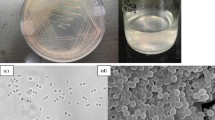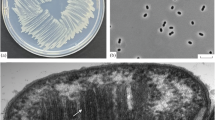Abstract
A novel mesophilic, methylotrophic, methanogenic archaeon, designated strain EK1T, was enriched and isolated from wetland sediment. Phylogenetic analysis showed that strain EK1T was affiliated with the genus Methanomethylovorans within the family Methanosarcinaceae, and shared the highest 16S rRNA and methyl-coenzyme M reductase alpha-subunit gene sequence similarity with the type strain of Methanomethylovorans hollandica (98.8 and 92.6 %, respectively). The cells of strain EK1T were observed to be Gram-negative, non-motile and irregular cocci that did not lyse in 0.1 % (w/v) sodium dodecyl sulfate. Methanol, mono-, di- and trimethylamine, dimethyl sulfide and methanethiol were found to be used as catabolic and methanogenic substrates, whereas H2/CO2, formate, 2-propanol and acetate were not. Growth was observed at 25–40 °C (optimum, 37 °C), at pH 5.5–7.5 (optimum, pH 6.0–6.5) and in the presence of 0–0.1 M NaCl (optimum, 0 M). Growth and methane production rates were stimulated in the presence of H2/CO2 although methane production and growth yields were not significantly affected; acetate, formate, 2-propanol and CO/CO2/N2 did not affect methane production. CoCl2 (0.6–2.0 μM) and FeCl2 (25 mg/l) stimulated growth, while yeast extract and peptone did not. The DNA–DNA hybridization experiment revealed a relatedness of <20 % between EK1T and the type strains of the genus Methanomethylovorans. The DNA G+C content of strain EK1T was determined to be 39.2 mol%. Based on the polyphasic taxonomic study, strain EK1T represents a novel species belonging to the genus Methanomethylovorans, for which the name Methanomethylovorans uponensis sp. nov. is proposed. The type strain is strain EK1T(=NBRC 109636T = KCTC 4119T = JCM 19217T).


Similar content being viewed by others
References
Altschul SF, Gish W, Miller W, Myers EW, Lipman DJ (1990) Basic local alignment search tool. J Mol Biol 215(3):403–410
Bellack A, Huber H, Rachel R, Wanner G, Wirth R (2011) Methanocaldococcus villosus sp. nov., a heavily flagellated archaeon that adheres to surfaces and forms cell–cell contacts. Int J Syst Evol Microbiol 61(Pt 6):1239–1245
Boone DR, Whitman WB (1988) Proposal of minimal standards for describing new taxa of methanogenic bacteria. Int J Syst Bacteriol 38:212–219
Coman C, Druga B, Hegedus A, Sicora C, Dragos N (2013) Archaeal and bacterial diversity in two hot spring microbial mats from a geothermal region in Romania. Extremophiles 17(3):523–534
De Bok FA, Van Leerdam RC, Lomans BP, Smidt H, Lens PN, Janssen AJ, Stams AJ (2006) Degradation of methanethiol by methylotrophic methanogenic archaea in a lab-scale upflow anaerobic sludge blanket reactor. Appl Environ Microbiol 72(12):7540–7547
DeLong EF (1992) Archaea in coastal marine environments. Proc Natl Acad Sci U S A 89(12):5685–5689
Deng Y, Zhang Y, Gao Y, Li D, Liu R, Liu M, Zhang H, Hu B, Yu T, Yang M (2012) Microbial community compositional analysis for series reactors treating high level antibiotic wastewater. Environ Sci Technol 46(2):795–801
Dridi B, Fardeau ML, Ollivier B, Raoult D, Drancourt M (2012) Methanomassiliicoccus luminyensis gen. nov., sp. nov., a methanogenic archaeon isolated from human faeces. Int J Syst Evol Microbiol 62(Pt 8):1902–1907
Ezaki T, Hashimoto Y, Yabuuchi E (1989) Fluorometric deoxyribonucleic acid-deoxyribonucleic acid hybridization in microdilution wells as an alternative to membrane filter hybridization in which radioisotopes are used to determine genetic relatedness among bacterial strains. Int J Syst Bacteriol 39:224–229
Felsenstein J (1981) Evolutionary trees from DNA sequences: a maximum likelihood approach. J Mol Evol 17(6):368–376
Garrity GM, Holt JG (2001) Phylum AII. Euryarchaeota phy. nov. In: Boone DR, Castenholz RW, Garrity GM (eds) Bergey’s Manual® of Systematic Bacteriology, vol 1. Springer, New York, pp 211–294
Gonzalez JM, Saiz-Jimenez C (2002) A fluorimetric method for the estimation of G + C mol% content in microorganisms by thermal denaturation temperature. Environ Microbiol 4:770–773
Hales BA, Edwards C, Ritchie DA, Hall G, Pickup RW, Saunders JR (1996) Isolation and identification of methanogen-specific DNA from blanket bog peat by PCR amplification and sequence analysis. Appl Environ Microbiol 62(2):668–675
Hungate RE (1969) A roll tube method for cultivation of strict anaerobes. In: Norris JR, Ribbons DW (eds) Methods in Microbiology, vol 3. Academic Press, New York
Jiang B, Parshina SN, van Doesburg W, Lomans BP, Stams AJ (2005) Methanomethylovorans thermophila sp. nov., a thermophilic, methylotrophic methanogen from an anaerobic reactor fed with methanol. Int J Syst Evol Microbiol 55(Pt 6):2465–2470
Kim OS, Cho YJ, Lee K, Yoon SH, Kim M, Na H, Park SC, Jeon YS, Lee JH, Yi H, Won S, Chun J (2012) Introducing EzTaxon-e: a prokaryotic 16S rRNA gene sequence database with phylotypes that represent uncultured species. Int J Syst Evol Microbiol 62:716–721
Kimura M (1980) A simple method for estimating evolutionary rates of base substitutions through comparative studies of nucleotide sequences. J Mol Evol 16(2):111–120
L'Haridon S, Reysenbach AL, Banta A, Messner P, Schumann P, Stackebrandt E, Jeanthon C (2003) Methanocaldococcus indicus sp. nov., a novel hyperthermophilic methanogen isolated from the Central Indian Ridge. Int J Syst Evol Microbiol 53(Pt 6):1931–1935
Liu Y, Whitman WB (2008) Metabolic, phylogenetic, and ecological diversity of the methanogenic archaea. Ann N Y Acad Sci 1125:171–189
Lomans BP, Maas R, Luderer R, Op den Camp HJ, Pol A, Van der Drift C, Vogels GD (1999) Isolation and characterization of Methanomethylovorans hollandica gen. nov., sp. nov., isolated from freshwater sediment, a methylotrophic methanogen able to grow on dimethyl sulfide and methanethiol. Appl Environ Microbiol 65(8):3641–3650
Lomans BP, Luderer R, Steenbakkers P, Pol A, Van Der Drift C, Vogels GD, Op Den Camp HJ (2001) Microbial populations involved in cycling of dimethyl sulfide and methanethiol in freshwater sediments. Appl Environ Microbiol 67(3):1044–1051
Lueders T, Chin KJ, Conrad R, Friedrich M (2001) Molecular analyses of methyl-coenzyme M reductase alpha-subunit (mcrA) genes in rice field soil and enrichment cultures reveal the methanogenic phenotype of a novel archaeal lineage. Environ Microbiol 3(3):194–204
Madigan MT, Martinko JM, Dunlap PV, Clark DP (2009) Archaea. Brock Biology of Microorganisms, 12th edn. Pearson Benjamin Cummings, san francisco, pp 487–515
Muyodi FJ (2000) Microbiological analysis of the waters of Lake Victoria in relation to the invasion of the water hyacinth, Eichhornia crassipes (Mart.) Solms. In A case study of the lakeshores of Mwanza municipality, pp. 158–173. PhD thesis, University of Dar es Salaam, Tanzania
Nei M, Kumar S, Takahashi K (1998) The optimization principle in phylogenetic analysis tends to give incorrect topologies when the number of nucleotides or amino acids used is small. Proc Natl Acad Sci U S A 95(21):12390–12397
Ovreas L, Forney L, Daae FL, Torsvik V (1997) Distribution of bacterioplankton in meromictic Lake Saelenvannet, as determined by denaturing gradient gel electrophoresis of PCR-amplified gene fragments coding for 16S rRNA. Appl Environ Microbiol 63(9):3367–3373
Plumb JJ, Bell J, Stuckey DC (2001) Microbial populations associated with treatment of an industrial dye effluent in an anaerobic baffled reactor. Appl Environ Microbiol 67(7):3226–3235
Pruesse E, Quast C, Knittel K, Fuchs BM, Ludwig W, Peplies J, Glockner FO (2007) SILVA: a comprehensive online resource for quality checked and aligned ribosomal RNA sequence data compatible with ARB. Nucleic Acids Res 35(21):7188–7196
Roest K, Altinbas M, Paulo PL, Heilig HG, Akkermans AD, Smidt H, de Vos WM, Stams AJ (2005) Enrichment and detection of microorganisms involved in direct and indirect methanogenesis from methanol in an anaerobic thermophilic bioreactor. Microb Ecol 50(3):440–446
Saitou N, Nei M (1987) The neighbor-joining method: a new method for reconstructing phylogenetic trees. Mol Bio Evol 4:406–425
Sakai S, Imachi H, Hanada S, Ohashi A, Harada H, Kamagata Y (2008) Methanocella paludicola gen. nov., sp. nov., a methane-producing archaeon, the first isolate of the lineage ‘Rice Cluster I’, and proposal of the new archaeal order Methanocellales ord. nov. Int J Syst Evol Microbiol 58(Pt 4):929–936
Schlotelburg C, Wintzingerode C, Hauck R, Wintzingerode F, Hegemann W, Gobel UB (2002) Microbial structure of an anaerobic bioreactor population that continuously dechlorinates 1,2-dichloropropane. FEMS Microbiol Ecol 39(3):229–237
Shen P, Zhang J, Zhang J, Jiang C, Tang X, Li J, Zhang M, Wu B (2013) Changes in microbial community structure in two anaerobic systems to treat bagasse spraying wastewater with and without addition of molasses alcohol wastewater. Bioresour Technol 131:333–340
Shi R, Zhang Y, Yang W, Xu H (2012) Microbial community characterization of an UASB treating increased organic loading rates of vitamin C biosynthesis wastewater. Water Sci Technol 65(2):254–261
Simankova MV, Kotsyurbenko OR, Lueders T, Nozhevnikova AN, Wagner B, Conrad R, Friedrich MW (2003) Isolation and characterization of new strains of methanogens from cold terrestrial habitats. Syst Appl Microbiol 26(2):312–318
Tamura K, Peterson D, Peterson N, Stecher G, Nei M, Kumar S (2011) MEGA5: molecular evolutionary genetics analysis using maximum likelihood, evolutionary distance, and maximum parsimony methods. Mol Biol Evol 28(10):2731–2739
Thompson JD, Higgins DG, Gibson TJ (1994) CLUSTAL W: improving the sensitivity of progressive multiple sequence alignment through sequence weighting, position-specific gap penalties and weight matrix choice. Nucleic Acids Res 22(22):4673–4680
Watanabe K, Kodama Y, Hamamura N, Kaku N (2002) Diversity, abundance, and activity of archaeal populations in oil-contaminated groundwater accumulated at the bottom of an underground crude oil storage cavity. Appl Environ Microbiol 68(8):3899–3907
Wayne LG, Brenner DJ, Colwell RR, Grimont PAD, Kandler O, Krichevsky MI, Moore LH, Moore WEC, Murray RGE, Stackebrandt E, Starr MP, Truper HG (1987) International Committee on Systematic Bacteriology. Report of the ad hoc committee on reconciliation of approaches to bacterial systematics. Int J Syst Bacteriol 37:463–464
Widdel F, Pfennig N (1981) Studies on dissimilatory sulfate-reducing bacteria that decompose fatty acids. I. Isolation of new sulfate-reducing bacteria enriched with acetate from saline environments. Description of Desulfobacter postgatei gen. nov., sp. nov. Arch Microbiol 129(5):395–400
Widdel F, Kohring GW, Mayer F (1983) Studies on dissimilatory sulfate-reducing bacteria that decompose fatty acids - III. Characterization of the filamentous gliding Desulfonema limicola gen. nov. sp. nov., and Desulfonema magnum sp. nov. Arch Microbiol 134(4):286–294
Wolin EA, Wolin MJ, Wolfe RS (1963) Formation of methane by bacterial extracts. J Biol Chem 238:2882–2886
Wu YR, He J (2013) Characterization of anaerobic consortia coupled lignin depolymerization with biomethane generation. Bioresour Technol 139C:5–12
Zoetendal EG, Akkermans AD, De Vos WM (1998) Temperature gradient gel electrophoresis analysis of 16S rRNA from human fecal samples reveals stable and host-specific communities of active bacteria. Appl Environ Microbiol 64(10):3854–3859
Acknowledgments
This work was supported by BK21 Plus program and by a grant from the National Institute of Biological Resources (NIBR), funded by the Ministry of Environment (MOE) of the Republic of Korea (NIBR No. 2013-02-055). The National Research Foundation of Korea (NRF) grant funded by the Korea government (MEST) (No. NRF-2013R1A2A2A05006754).
Author information
Authors and Affiliations
Corresponding authors
Additional information
In-Tae Cha and Ui-Gi Min contributed equally to this work.
Rights and permissions
About this article
Cite this article
Cha, IT., Min, UG., Kim, SJ. et al. Methanomethylovorans uponensis sp. nov., a methylotrophic methanogen isolated from wetland sediment. Antonie van Leeuwenhoek 104, 1005–1012 (2013). https://doi.org/10.1007/s10482-013-0020-4
Received:
Accepted:
Published:
Issue Date:
DOI: https://doi.org/10.1007/s10482-013-0020-4




